Early Detection of Coronavirus Infection Using Heart Rate Variability
Remote Longitudinal tracking of HRV
Information Sheet for participating in a research project
There have been two primary difficulties in trying to cope with the Corona virus pandemic. The first is that people can contract the virus and be infectious, but not have any symptoms for several days or possibly weeks, before they start to feel unwell and go into quarantine.
The second problem is that for a small percentage of the people that do get a ‘bit’ unwell, after some time they suddenly deteriorate and require hospitalisation, but for many people they leave it too late before seeking help and this increases their risk of complications and prolongs recovery time.
When people contract the coronavirus, their body mounts an immune response and there is evidence to suggest that this can be measured with heart rate (HR) and heart rate variability (HRV), several days before people start to feel any symptoms.
Heart Rate and HRV are two slightly different measures, heart rate obviously is the average number of heart beats per minute and generally the healthier a person is, the lower their heart rate is at rest. Heart rate variability on the other hand, is a measure of how much variability ‘in time’, there is between successive heartbeats and generally the larger the variability the better.
The heart does not beat like a metronome and should speed up when you are active or stressed and slow down at rest and in recovery mode. In fact, if your heart behaved like a metronome with very low variability this would be a very serious sign. There is some evidence that HRV can be used as a stress measure.
Of course, like many measures of human activity, there is a great range of values across the population and a large variability within one person during different activities and at different times of the day and across the life span. So, for example HRV tends to decrease with age and increase with happiness.
This is where having your own “personal baseline” can give you a great deal more information, than just taking a single HRV measure and comparing it to people of the same age. So, with a regular record of HRV, you will be able to detect when it starts going out of ‘your’ normal range. This could help you spot that something is going wrong and then you can work out what to do about it before it gets out of hand. For example, in recent years sports people have started taking a daily HRV measurement first thing in the morning, before they get up, to see if they had “over trained” the day before. If their HRV is lower than usual, they will take it easy for a day.
So, we would like you to record a daily 5-minute HRV measurement once a day for 30 consecutive days (or as close as you can get to this). But we want to check two different devices. We would like to use a Camera Phone App, this would be a cheap solution, so millions of people could use it but we are not sure it will work for everyone, so we also want to check a cheap ear clip sensor.
Therefore, we would like you to do two measurements daily. If you have two different smart devices, like a smart phone and a tablet it would be possible to do both measurements at the same time but if you only have one device, you would need to do the measurements sequentially one straight after the other.
If you and a partner both want to take part in the study, you can share the Kyto ear clip, but it will be easier if you use your own smart phone. Then all the summery information will be for each of you. If you agree to take part in this study a requirement is that you try and record measurements in a similar manner every day, it doesn’t matter whether you’re sitting or lying down but ideally it would be best if you do it the same way each day.
So, for example, I decided to do the recordings first thing in the morning before I got up, as there is some evidence to suggest this is a more stable and informative measure, but sometimes I forget, so I just go back to bed for a few minutes and make the recording, because there can be a large difference between when you are lying down and sitting up. If you do forget to do the measurement all together that’s life, you can just do the measurement at a different time of day or location. It’s better than not having a measurement for that day. But clearly the more consistently your measure, the more useful it will be.
For this pilot study we will only be collecting the HRV data and analysing it at the end of the study, but ultimately if the study works the plan would be to be able to alert people when there HRV starts going out of range, so they can quarantine or take medical advice.
All your data will be stored with an anonymous participant ID number and we will give you an anonymous email address to use in the Apps.
So, we will only publish or share the anonymised data and in accordance with open science guidelines, we may share the data on a publicly accessible repository indefinitely. All personal identifiable information like emails and names etc. will be kept in a password protected spreadsheet on a password protected computer and not shared.
We would also like you to keep a track of how you feel and of course if you do contract coronavirus. In the Elite HRV App when you have done a HRV recording you will have the option to log a number actives such as Sleep, and an illness. (See the ‘Installation and Setup’ below or the PDF for information on how to do this).
We would also like to know the make of phone or tablet you are using in the study, and at the end of the 30 days we will send you a short questionnaire to find out how you found doing the measurements. (At the bottom of this page)
As part of this study we have tested several other devices like fitness trackers and smart watches but although they are accurate at measuring heart rate, they are generally not designed to capture heart rate variability and the ones we have tested have had very low accuracy. However, if you do have another device that you use to record heart rate or anything else, and are happy to share it, that would be great. (There are so many different devices these days, that we have not been able to test, so data from other devices may help to verify their usefulness)
At the end of the study if you have found the ear clip useful you are welcome to keep it and if you are happy to keep sharing the data that would be great. But if you’re going to just throw it in a drawer, please can you post it back to us and we will use it on subsequent studies.
Thank you very much for your time and effort and we hope this data will be useful.
I would be very happy to chat with you about the study or HRV in general, and if you have any question just email or call.
Consent Form
Once you have read the Information above, if you have any questions you can email me, or we can arrange a time to chat.
1. When you are ready to fill in the ‘consent form’, can you please click on the button below and the PDF will open in a new web page.
2. Then click on the buttons in the PDF to answer the questions and enter the ‘Name’, ‘Date’, and ‘Email’.
3. Then can you go to “Print” the form, BUT instead of printing it to paper with your printer, select “Save as PDF” and “Print” to save to your computer.
(This way all the information you have entered in the form will be kept). Then can you email the newly saved PDF form to me ![]() .
.
Installation and Setup
Installation and setup for the Kyto Ear Clip and the CameraHRV App for the research project
We have two recordings we would like you to do every day, so before you instal any apps have a think about how you want to do this.
If you have two smart devices, like a phone and a tablet it may be easiest to instal the camera HRV app on the phone and the ear clip app on the tablet. Then when you want to take a recording you could just start recording the ear clip data with the elite HRV app then start the camera HRV app to record from your finger.
If you have only got one device, it is possible to do both recordings simultaneously, but you just need to be a little bit more organised. Again, start the elite HRV recording then you can minimise it and start recording with the camera HRV (It has to be this way around as if you minimise the camera app it stops working). The elite HRV app will vibrate and give a beep when it has finished recording but you can just ignore this until you have finished recording with the camera HRV. Once you have finished the camera HRV recording name the session and save then switchback to the elite HRV app and save that recording.
Once you get used to it, it is not as difficult as it sounds. BUT you can always just record one followed by the other, it will take a bit longer, but it is a lot simpler to do.
One point to note is that on an Android phone, the camera flash can get a bit hot to hold your finger on and on some devices seems to only record for one minute. So, it may be better to use an iPhone for the camera HRV App if you can.
Installation and setup:
First, please charge the Kyto device by plugging in the charging cable into a USB port on a phone charger or computer.
To record the HRV data from the Kyto ear clip device, we are using a smartphone app called “Elite HRV”. It is available for both Android and iPhone.
Elite HRV – https://elitehrv.com/
https://play.google.com/store/apps/details?id=com.elitehrv.app&hl=en_GB
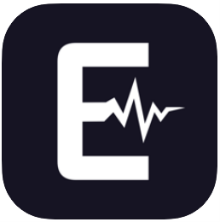
Please download the app from the “Google Play” store or Apple “App Store” and I will send you an anonymous participant ID name and anonymous participant email address and Password, to log-in to the Apps.
When you first open the Elite HRV App, you will be asked “What Brings you…” just select what best fits. Then select “Sign up With Email” . Please use the anonymous participant email and Password that I have sent you and save it. Then accept the “Policy & Terms”.
Then you will be asked to “Connect My Sensor” to connect the Kyto ear clip device to your smartphone, first make sure your phone’s Bluetooth is enabled. Then plug in the ear clip into the Kyto which will turn it on and put it on your ear lobe. The name of the Kyto will be something like “BT_HRM_9_XXXX….”.
The App will prompt you to record some HRV data. When you have done this can you please click on the blue head icon in the top right corner. This takes you to your profile page and then click on the “View Profile”. Can you put your anonymous participant ID name in the “Name” field and fill in the other fields, (If you do not want to put your full ‘Date of Birth’ you can put the 1st of January and your year of Birth).
To start taking a measurement a new session, press the circular button with a plus mark in the middle on the bottom (It will look slightly different in different devices).

You will be presented with three options “Morning HRV test”, “Open reading”, and “HRV snapshot”.
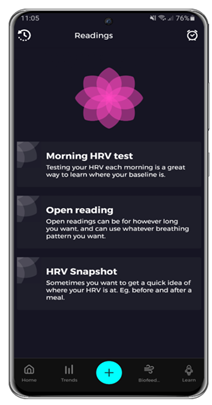
Use the “Morning HRV test” option for the first thing when you wake up while you are still lying down in bed, you can only do this once a day.
To do your HRV recording at any other times use the “Open reading”.
The “HRV snapshot” is just to take a 1-minute recording which is not use to this study. You can do ether the “Morning HRV test” or “Open reading”. But the App encourages you to do the morning recording, so most plots and summary statistics are about the morning recording. So, I do both the morning and an open recording in the evening every day.
The first time you go to either of these options you will need to set the recording time to “5:15”. You also need the select your “Body position”, you can have:
Sitting, Standing, Lying Down, Squatting, or On the Go.
There has just been an update to the software, so there is a difference between the iOS and Android. (but this will probably change on the Android soon)
On the Android there is an option to have a “Stabilization period”. This is some time after you press the “Take Test” button before the recording starts. This means you can put the phone down and get comfortable. Then once the App has started to record your HRV, you can slide to the right to get the display that shows your heart rate in real-time.
On the iOS, when you press the “Take Test” button you will see a live preview of the HRV data, BUT it is not recording, so when you are settled, comfortable and have a good signal. you need to press the “Start Reading” and the countdown will start.
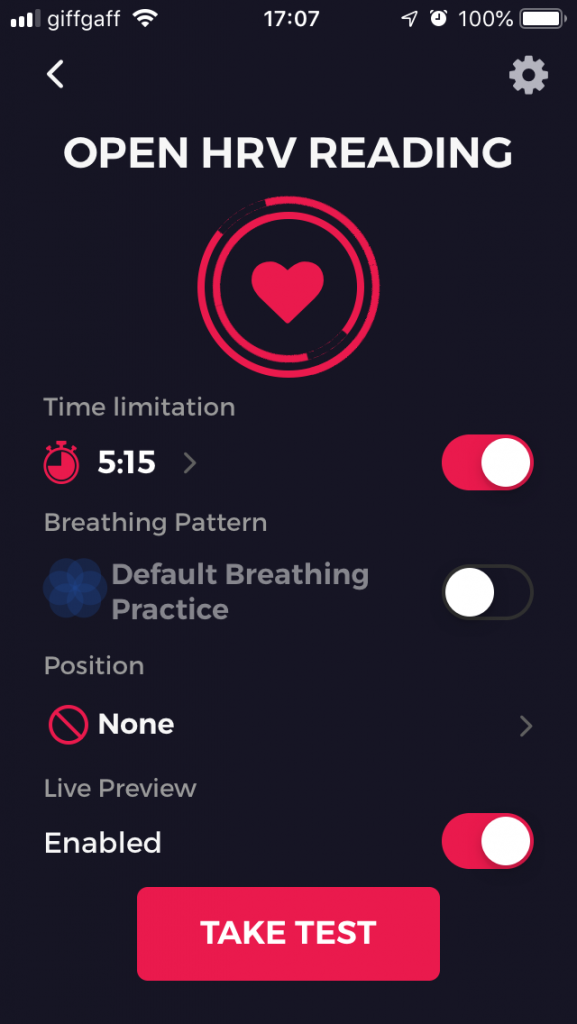
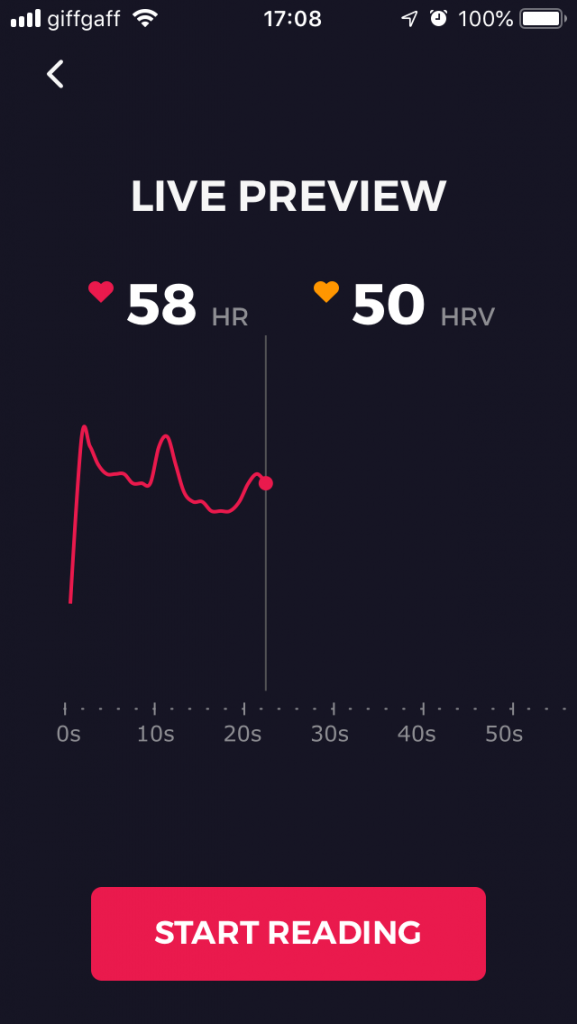
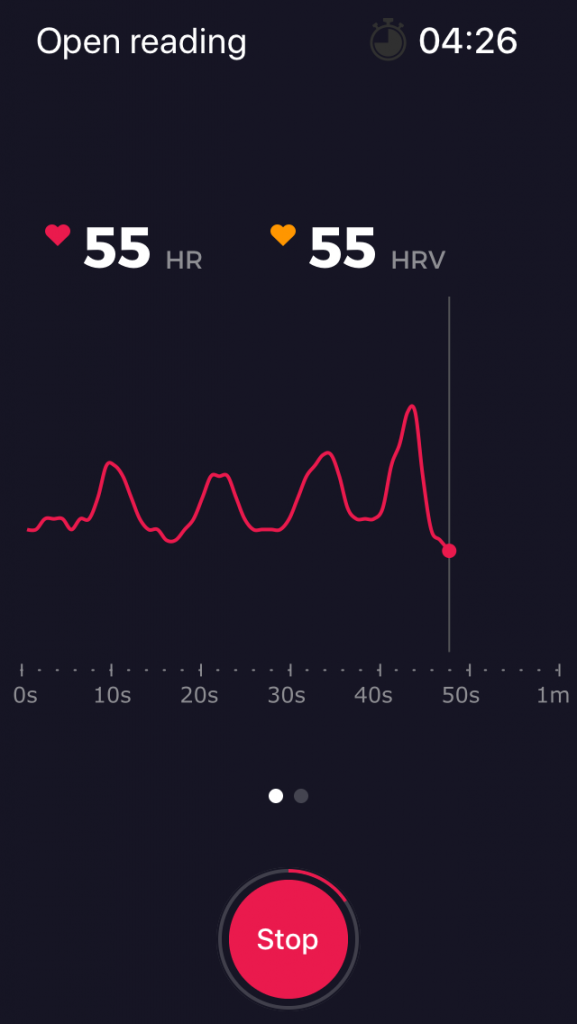
Ignore the website or app that says “just two minutes a day” this is not enough data to get an accurate measure. We want just over 5-minutes of “Good” data.
Now, this is the difficult part of the study, how to get “Good” HRV data:
The sensor works by shining Infrared light through the skin so the oxygen in your vessels absorb it. This means when you put the ear clip on your ear lobe, you need to make sure all of the sensor is “Seeing” your ear lobe.
If the App can not connect to the Kyto sensor, first try moving the sensor on your ear lobe and if this does not work cheque your Bluetooth is on and the device is charged. the device can behave a little bit oddly when the battery is getting low.
When you are recording your HRV data, (particularly with the camera phone App which I will explain next), you need to be as still as you can and preferably not talking for the whole 5-mins.
You can clip the Kyto to your top or collar, near your ear, so if you move your head it does not move the cable too much.
Remember to un-plug the ear clip from the Kyto to turn it off, the Manufacturers claim you can record for 20 hours but I charge it every day just in case.
To join the Elite HRV MindSpire Team:
You can join the MindSpire Team in the Elite HRV App, on the home page press the “Blue Head icon” in the top right-hand corner to take you to your “Profile” page. Then push the “My teams” tab.
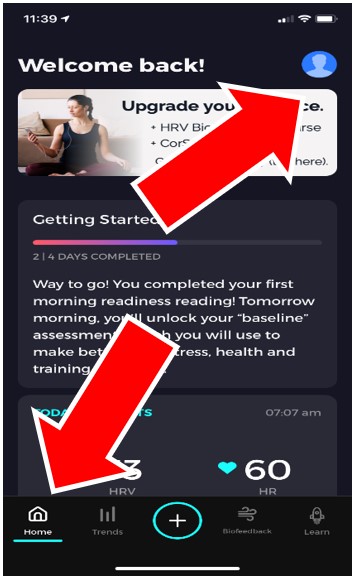
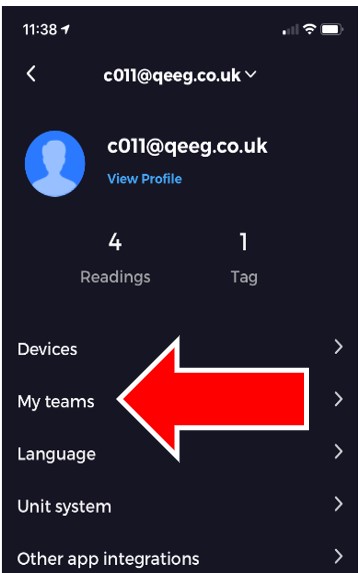
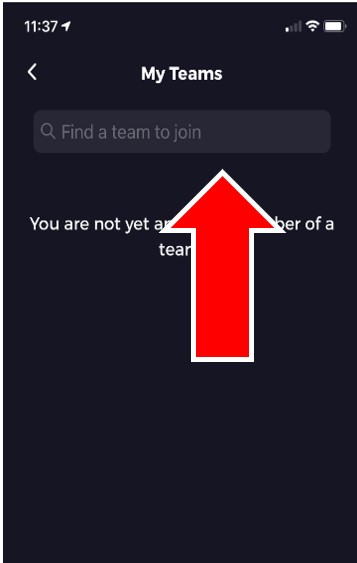
The “My Teams” page will be empty. In the search bar type “MindSpireHRV1”
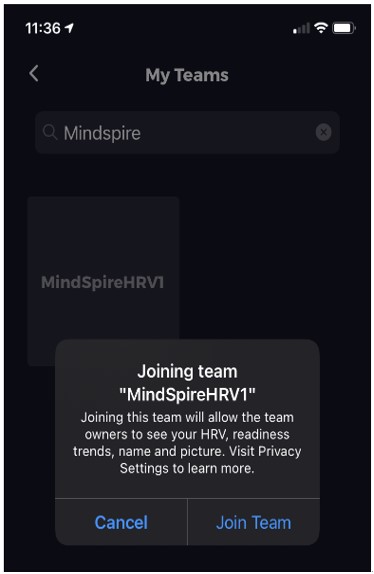
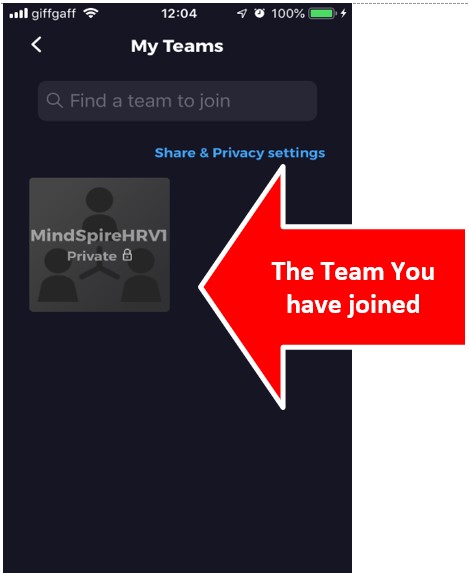
Then “Join Team”, I will be notified and will have to “Accept” you into the team, so this may take a little time. You can start taking your recordings straight away, as I can collect all the previous sessions once you have joined the team.
Logging your daily activity:
When you have finished the morning recording, the app will make a noise and prompt you to save the recording. You have an option to add some extra details about how you feel or if you are ill and if you have done any exercise or how you slept etc.
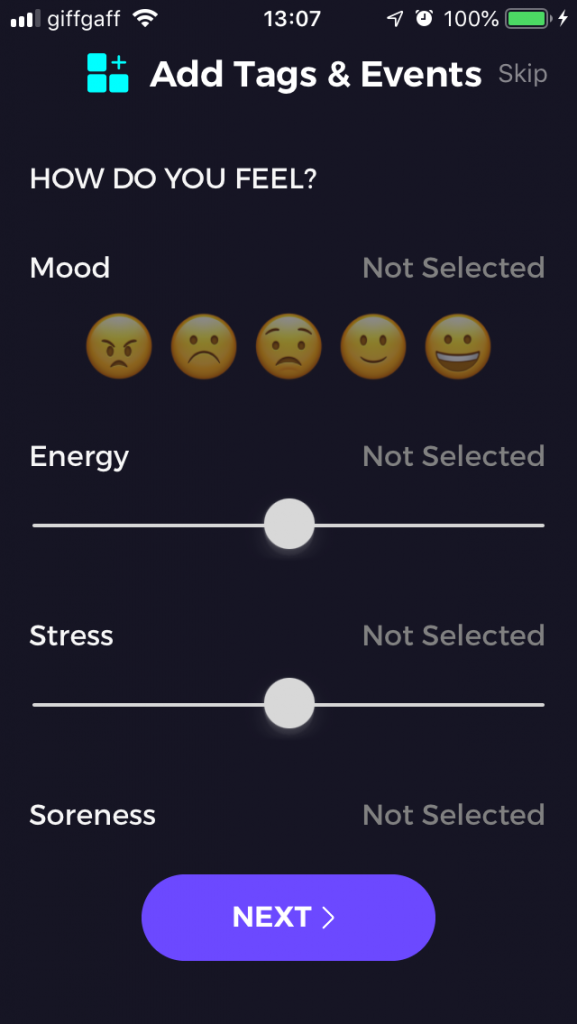
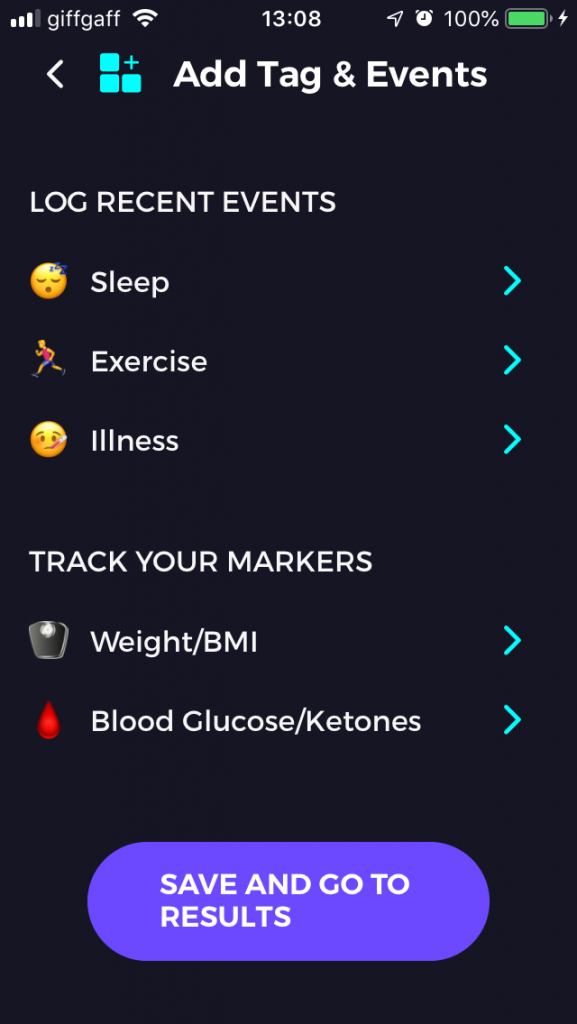
You can also add tags at any time by clicking on the “Clock & Anticlockwise arrow” icon in the top left-hand corner of the recording screen. This takes you to the “Previous logs” page and then you can select the ‘blue plus’ and add any tags.
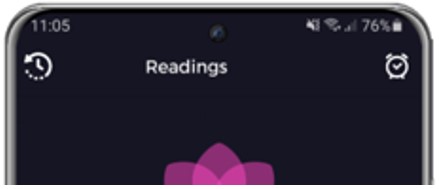
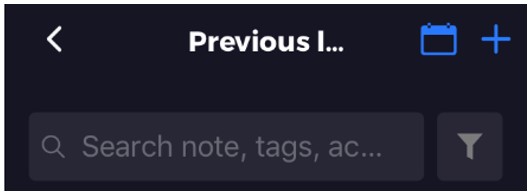
We would like you to rate your “Sleep” with the Thumbs up, level or down.
And also log if you get any illnesses.
You can choose from:
- Healthy
- COVID-19
- Influenza Brackets (Flu)
- Common Cold
- Stomach or Gastrointestinal
- Other
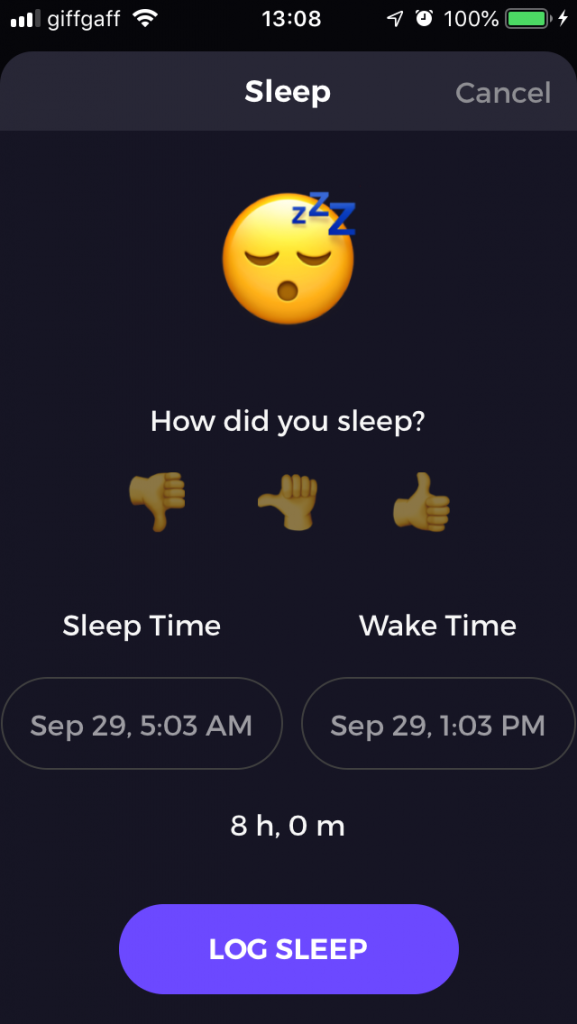
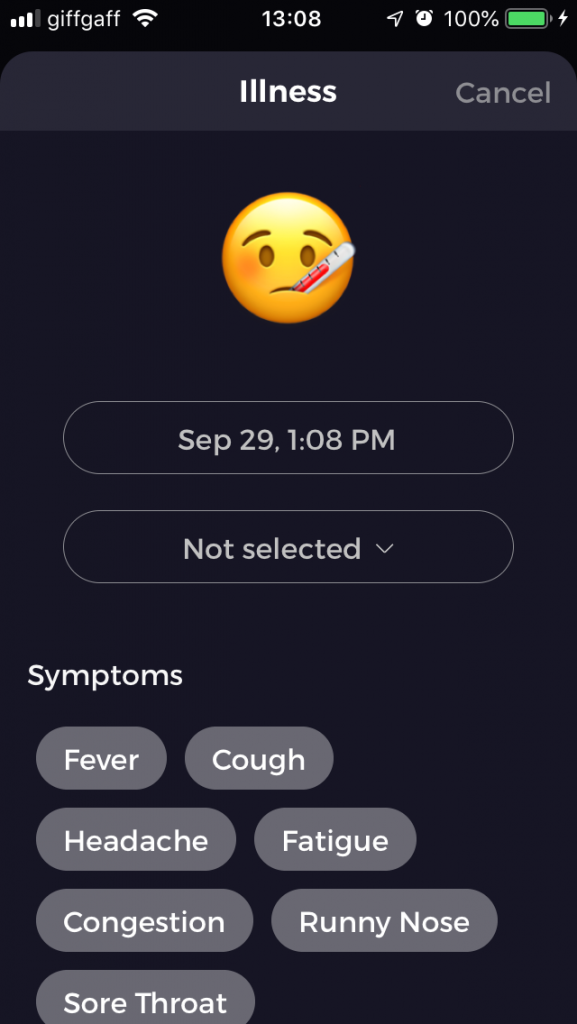
Sleep:
- Thumb up
- Thumb level
- Thumb down
Illness Symptoms:
Fever, Cough, Headache, Fatigue, Congestion, Runny Nose, Sore Throat, Difficulty Breathing, Stomach Pain, Diarrhea, Nausea, Muscle Aches, Other
If you like; you can log anything else that may be of interest to you, for example the app will allow you to log. Exercise: There are lots of options to choose from. Sleep: You can connect to other hardware or the Apple health app if you like. Energy, Blood Glucose, Ketones, Weight/BMI.
There is an option to schedule a reminder to take a recording in the App.
You can easily share the Kyto device, but you will need to use your own smartphone or tablet. That way all of the summery data in the App will be about one person.
Remember to un-plug the ear clip from the Kyto when you are not using it and charge it regularly.
Camera Heart Rate Variability App
The App we are using to take the Camera Phone HRV measurements is called “Camera Heart Rate Variability” from A.S.M.A B.V. It costs £4.19 for Android, and £6.99 for Apple devices. We will reimburse this fee just let us know how we should pay you this money.

Lorem ipsum dolor sit amet, consectetur adipiscing elit. Ut elit tellus, luctus nec ullamcorper mattis, pulvinar dapibus leo.
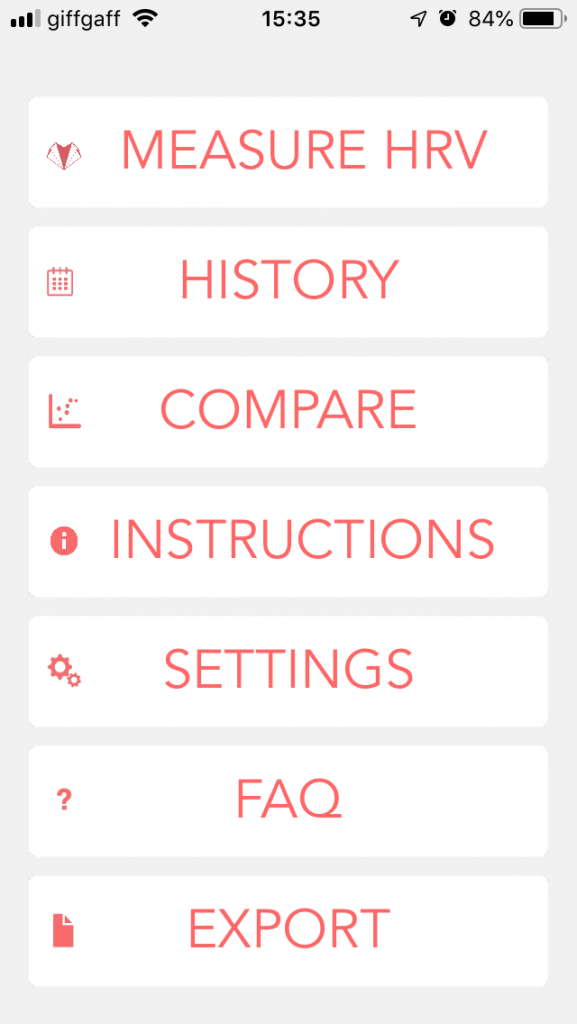
First in the main screen push “SETTINGS” set the “Features Computation Window” to “60 sec”.
Next set the
“Breathing Rate” to “off”.
“Heart Rate” = Off
“RR-Intervals” = On
“Features” = On
In “Your Email” add your anonymous participant email address.
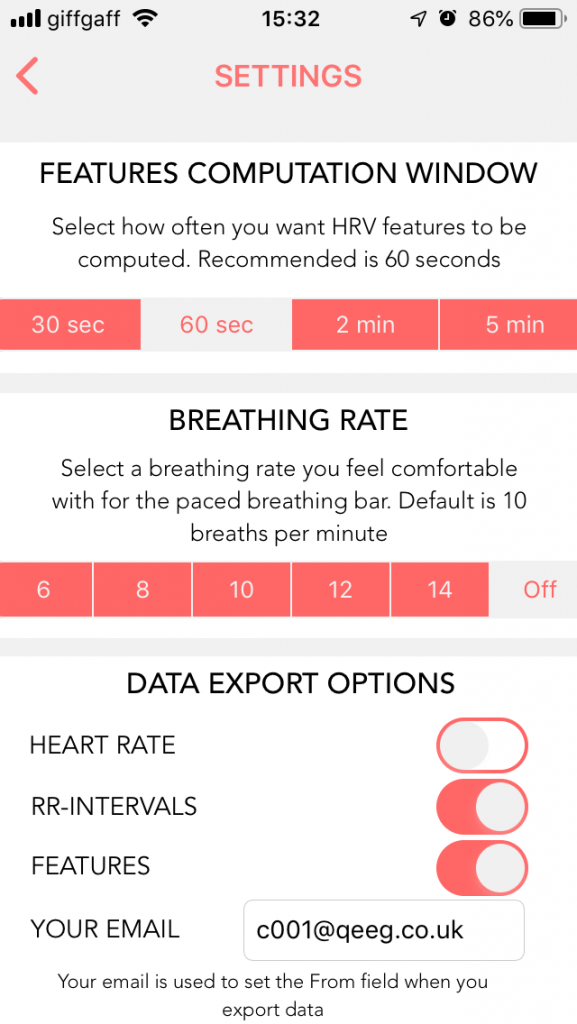
To take a measurement, place a finger over the camera and light, so the light shines into your finger.
Push “MEASURE HRV” and you will see a screen like this.
On the top left is a red round window, which is a video of your finger. You can adjust your finger to get a good signal.
You want to see a clear “Bump” that looks like the middle trace. If you move, you will get a “spike” in the signal and it will take a few second for the scale to reset. You need to check that the heart rate makes sense!
Every 60-seconds a small window will pop up to tell you if you have obtained an accurate measurement. Try and sit still during the recording. I find it easiest to sit at a desk where I can rest my hands on the table or put the phone in a stand.
Here is some more info on getting a good signal:
https://www.hrv4training.com/blog/how-to-get-the-most-out-of-your-camera-measurement
When you have recorded just over 5-minutes of good data, (you may have to wait for the pop-up window to disappear), push stop and name the file.
Could you please use your anonymous participant ID and your Body position as the file name. So, something like this “c001 sit”.
Then can you then regularly email me the file by pushing the paper icon in the bottom right of the file’s history page, and “Send by email” to c001@qeeg.co.uk. which I will keep on a password protected and secure computer.
I am happy to chat about the study and answer any questions you have. We can also arrange a time to call or video conference, if you are having trouble with the equipment.
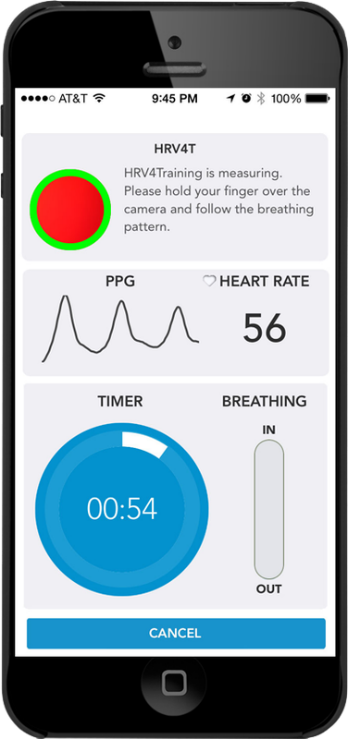
Thank you very much. and contact me if you have any questions.
Tony Steffert
Post 30 day Questionnaire
Thank you for taking part in this study.
Now that you have done at least 30 days of recordings, we would like to ask you some questions about your experience.
This should only take a few minutes and we just want your initial thoughts and feelings on how it was to record your heart rate variability every day, what did you found good or bad, about the study and whether the information could be useful to you.

